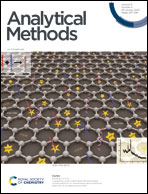An Ag–TiO2–reduced graphene oxide hybrid film for electrochemical detection of 8-hydroxy-2′-deoxyguanosine as an oxidative DNA damage biomarker†
Abstract
In the present work, a notably sensitive and selective electrochemical 8-OHdG sensor based on an Ag–TiO2–reduced graphene oxide (rGO) hybrid nanomaterial modified screen-printed electrode (SPE) was developed for 8-hydroxy-2′-deoxyguanosine (8-OHdG) determination, which is a significant DNA biomarker because it is one of the main products of oxidative DNA damage. The amperometric responses of the fabricated sensor (Ag–TiO2–rGO/SPE) were measured via monitoring the oxidation current of 8-OHdG by using the differential pulse voltammetry (DPV) technique. The effects of the rGO : Ag–TiO2 ratio, amount of Ag–TiO2–rGO on the electrode surface, electrolyte pH, and possible interfering substances on the current response of Ag–TiO2–rGO/SPE were investigated in detail. Under optimized conditions, the current signals linearly correlated with the concentration of 8-OHdG in the range of 0.05–25 μM (R2 = 0.9967) with a detection limit of 10 nM. Furthermore, Ag–TiO2–rGO/SPE was successfully tested to determine the 8-OHdG level in a human urine sample (only in a volume of 50 μL) with satisfactory recovery.



 Please wait while we load your content...
Please wait while we load your content...